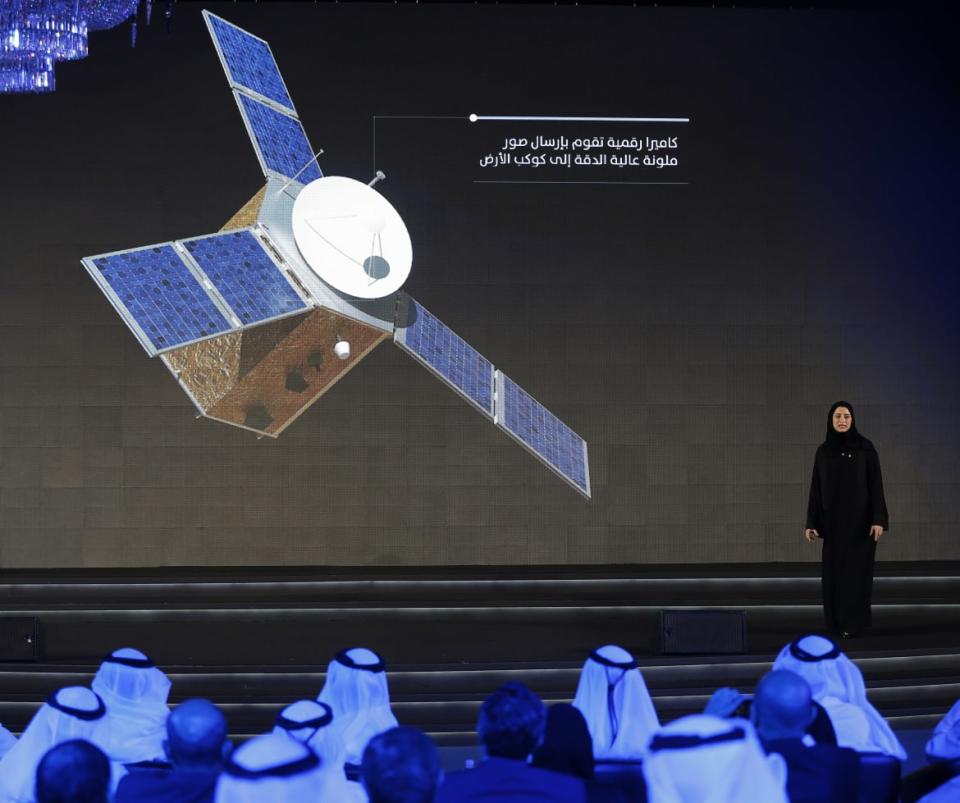How Sarah Al Amiri Is Launching the UAE Into the Asteroid Belt

When Sarah Al Amiri grew up in the United Arab Emirates (UAE), space wasn’t something that she—or really anyone else—paid that much attention to. That’s something that you might take for granted if you grew up in, say, the U.S. or Russia where space exploration is embedded into the cultural fabric of the country. But in the UAE, a country that was just 16 years old when Amiri was born, space just wasn’t a priority.
“When you grow up in the U.S., you already have those space programs there,” Al Amiri told The Daily Beast. “We didn’t have even a semblance of that when I was growing up. It was something you thought of as a fascination—not a career choice.”
It’s ironic then that she would go on to not only become the Minister of State for Science but also the first chairwoman of the United Arab Emirates Space Agency (UAESA). She deserved it, too. After all, she had helped lead the UAESA’s Mars Hope mission to the red planet as the project’s science lead.
Since then, Amiri has been helping lead the UAESA into even more ambitious “moonshot” projects—including literally going to the moon. In April, the agency sent a rover to the lunar surface with the Japanese private aerospace company ispace. While the lander ended up crashing on the moon—and, with it, the UAESA’s rover—Amiri said that the mission only doubled the agency’s resolve to try again and go even further.

Amiri at a ceremony to unveil the Mars Hope mission on May 6, 2015, in Dubai. Since then, Amiri has been helping lead the UAESA into even more ambitious “moonshot” projects.
The team certainly has their work cut out for them in their next moonshot too: the UAESA is partnering with the University of Colorado Boulder to launch a mission to the asteroid belt in 2028. The project is arguably a much more daunting undertaking than making it to Mars because the asteroid belt is much farther away (sitting between Mars and Jupiter), and the team will have to contend with the hostile and ever-changing dynamic of the belt.
Amiri sat down with The Daily Beast for a quick chat about the asteroid belt mission, the boom of commercial space projects, and whether or not she thinks aliens exist—and have already visited Earth.
(This interview has been edited for clarity and length)
While other space agencies seem to be very focused on establishing a presence on the moon and Mars, the UAESA’s next major project is going to be the asteroid belt. Why there?
We were putting together what we wanted to do after getting to Mars and we asked, “What’s next?” Is it going to be around big moonshots to be a catalyst for transformation and change from the country [like the Mars Hope mission]? Is it going to drive opportunities within commercial space?
The asteroid belt made sense in terms of the future of space. We could research space resources for future human exploration and the origins of water-based asteroids. At the same time, it stretched our technological ability to a certain point where we could use portions of the design of the Emirates Mars mission and add on new developments. That creates an interesting environment for developing science and technology capabilities. So, it just hit a nice sweet spot for scientific potential and technological capabilities.
We Found the Building Blocks of Life Hiding in Asteroid Dust
Are there any plans for the next big moonshot after this one?
You get to a point where you keep on thinking of budgets and risk delivery, so I haven’t opened up the realm of thinking about it. [laughs] For me, it’s more about sustainability in terms of what is going to be developed. One is a sustained exploration mission, where we’re able to turn around two or three exploration missions, and develop them in conjunction. Two is a very robust commercial space industry that is supplying spacecrafts for Earth observation purposes and at a rapid pace.
And I’d love to see ripple effects start happening within our ecosystem in our other sectors as well. We’re learning quite a lot from the policies that have been implemented in the space sector like biotech is something that we’re investing in greatly. So space has catalyzed a lot of change, not only in the space sector in the UAE, but it’s also catalyzed an interesting ripple effect in terms of the aspirations of moving forward our other industrial sectors in the country.
I think it’s interesting that you keep going back to the commercial aspect and opportunities for the space program.
It’s a global aspect really because commercial space has been untapped, and so several government entities like NASA and other space agencies around the world are all starting to rely on outsourcing a lot of the requirements to third parties. This frees up resources for more cutting-edge innovative technologies. And this is a natural progression. It means that the space sector globally is healthy and can form a symbiotic ecosystem with the public and private.
Can This Private Mars Mission Find Aliens Before They’re Lost Forever?
With the growth of private aerospace companies like SpaceX and Blue Origin, we’re seeing a lot more commercial opportunities in space—largely backed by private entities. How do you envision the future of the UAESA’s partnership with private companies?
We work very well with the private sector today, we also work with individuals that want to start off their businesses in the private sector. For example, some individuals who were a part of our previous missions have now started their companies, and they’re now developing the mission concept of the lander that will be onboard our mission to the asteroid belt.
We’ve also enabled quite a few companies to develop projects for Earth observation—especially for monitoring and fighting climate change. We’ve also worked on developing programs to ensure that we’re engaging more companies in helping develop our spacecrafts. This can range from things like harnesses, mechanical parts, and so on.
I have to ask: With the entire world seeming to have gone crazy over UFO sightings recently, do you believe aliens exist?
Yeah, I do. It doesn’t make sense that we’re the only living beings out there.
NASA’s UFO Report Shows They’re Serious About Finding Aliens
Do you think these UFOs are aliens visiting us, though?
If you factor in statistical repeatability, and if you factor in the timeline of the universe, and you factor in where we exist in that timeline and the formation of planets and that distance to be traveled to get to us… I don’t know if there isn’t any kind of technology that is able to visit Earth. This is within the context of time with the understanding of evolution, and with our understanding of what life looks like.
So I don’t know if those are alien interventions—but logic says that it requires quite a lot for an alien species to be able to get to Earth from whichever solar system they come from, considering the vastness of space and time. So yes, there is probably alien life, but some of it depends on our understanding of what life is.
There might be life out there that is completely different from what we understand or what we can construe as life. And at the same time, our lifetime [as humans] is non-consequential in the larger space of universe time. So you don’t know where aliens existed and at what point of time it exists—and for how long.
Get the Daily Beast's biggest scoops and scandals delivered right to your inbox. Sign up now.
Stay informed and gain unlimited access to the Daily Beast's unmatched reporting. Subscribe now.

